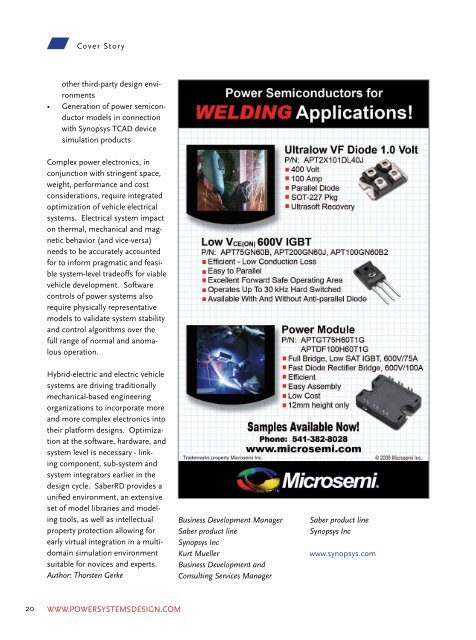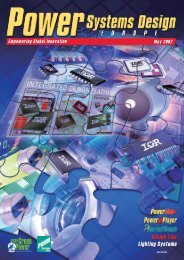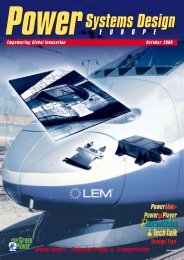Testing Virtual ECUs - Power Systems Design
Testing Virtual ECUs - Power Systems Design
Testing Virtual ECUs - Power Systems Design
You also want an ePaper? Increase the reach of your titles
YUMPU automatically turns print PDFs into web optimized ePapers that Google loves.
20<br />
Cover Story<br />
other third-party design environments<br />
• Generation of power semiconductor<br />
models in connection<br />
with Synopsys TCAD device<br />
simulation products<br />
Complex power electronics, in<br />
conjunction with stringent space,<br />
weight, performance and cost<br />
considerations, require integrated<br />
optimization of vehicle electrical<br />
systems. Electrical system impact<br />
on thermal, mechanical and magnetic<br />
behavior (and vice-versa)<br />
needs to be accurately accounted<br />
for to inform pragmatic and feasible<br />
system-level tradeoffs for viable<br />
vehicle development. Software<br />
controls of power systems also<br />
require physically representative<br />
models to validate system stability<br />
and control algorithms over the<br />
full range of normal and anomalous<br />
operation.<br />
Hybrid-electric and electric vehicle<br />
systems are driving traditionally<br />
mechanical-based engineering<br />
organizations to incorporate more<br />
and more complex electronics into<br />
their platform designs. Optimization<br />
at the software, hardware, and<br />
system level is necessary - linking<br />
component, sub-system and<br />
system integrators earlier in the<br />
design cycle. SaberRD provides a<br />
unified environment, an extensive<br />
set of model libraries and modeling<br />
tools, as well as intellectual<br />
property protection allowing for<br />
early virtual integration in a multidomain<br />
simulation environment<br />
suitable for novices and experts.<br />
Author: Thorsten Gerke<br />
WWW.POWERSYSTEMSDESIGN.COM<br />
Business Development Manager<br />
Saber product line<br />
Synopsys Inc<br />
Kurt Mueller<br />
Business Development and<br />
Consulting Services Manager<br />
Saber product line<br />
Synopsys Inc<br />
www.synopsys.com<br />
EMC COMPLIANCE<br />
Best practice design recommendations<br />
By Paul Lee<br />
ELECTROMAGNETIC COMPATIBILITY<br />
POWER SYSTEMS DESIGN JULY/AUGUST 2011<br />
International regulations regarding electromagnetic<br />
compatibility (EMC) affect many aspects of circuit and system<br />
design. However, there are numerous techniques that can be<br />
applied to reduce both the emissions from and susceptibility<br />
to, electromagnetic interference (EMI).<br />
S<br />
tarting at the power supply<br />
end of the system,<br />
make sure that any<br />
supply line loops are<br />
minimized and the lines are decoupled<br />
at local boundaries using<br />
filters with low Q (see Figure 1).<br />
High-speed sections of the system<br />
should be placed closest to the<br />
power line input, and the slowest<br />
sections further away, to help reduce<br />
power plane transients.<br />
Make use of low pass filters on signal<br />
lines to reduce the bandwidth<br />
to the minimum necessary. On<br />
wide bandwidth lines, keep feed<br />
and return loops close. The terminations<br />
of lines carrying HF or RF<br />
signals need to be implemented<br />
correctly to minimize reflection,<br />
ringing and overshoot. Lines carrying<br />
signals external to a board are<br />
best terminated at the board edge;<br />
avoid lead terminations within the<br />
board and loose leads crossing the<br />
board. It’s important that all sig-<br />
Figure 1: Supply lines – eliminate loops and decouple at local boundaries<br />
nals on the board are tracked with<br />
no ‘flying leads’.<br />
To avoid resonance within a signal<br />
conductor, steer clear of cabling or<br />
tracking which is close to a quarter<br />
wavelength of the signal frequency.<br />
Slew rate limiting, that is, minimizing<br />
rise and fall times on signal<br />
and clock edges, reduces crosstalk<br />
since sharp edges produce wide<br />
HF spectra.<br />
PCB Considerations<br />
There are quite a few things to<br />
consider when optimizing a PCB<br />
layout for EMC performance. The<br />
following aspects of board design<br />
should be avoided. The use of slit<br />
apertures, particularly in ground<br />
planes or near current paths. Also,<br />
do not use narrow tracks for power<br />
lines. This creates areas of high<br />
impedance and gives rise to high<br />
EMI. Do not overlap power planes.<br />
Keep them separate over common<br />
ground in an attempt to reduce<br />
system noise and power coupling.<br />
Track stubs should not be used.<br />
WWW.POWERSYSTEMSDESIGN.COM<br />
21









